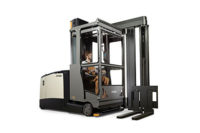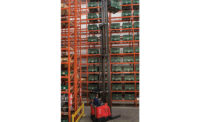Frontline Forklifts
How the pandemic put increased demands on lift trucks, and what technology is needed today.

The pandemic highlighted the value of automated guided vehicles (AGVs) since they're not affected by viruses, extreme cold conditions, and can work around the clock. However, some operators say AGVs aren't as fast as manually driven forklifts, so dual-mode lift trucks are a growing option for today's cold chain. (Image courtesy of Stromcore.)
The pandemic has undoubtedly accelerated every aspect of cold chain logistics over the past year, and that rapid pace is now the new normal. Perhaps forgotten in the crush to fulfill orders at breakneck speed is the humble forklift, which in nearly every cold foods facility was put to use for longer hours than ever before in loading and unloading goods.
“The COVID-19 pandemic has brought new urgency and complexity to how companies maintain or increase operational efficiency while ensuring a safe working environment,” says Jim Gaskell, director of global automation and emerging technologies, Crown Equipment. “Companies are realizing it’s important to understand how and when their forklifts are being used to help prepare operations for unexpected shortages and delays, as well as shifting consumer expectations.”
The coronavirus crucible that tested lift truck limits has increased the need for operators to implement safety precautions, automation, and smarter battery technology related to forklift use. Here, we’ll take a closer look at those areas and what current solutions are available to meet today’s challenges.

Blue spotlights on lift trucks like the ones seen here are a simple safety feature to help alert those around the vehicle when it's being used. (Image courtesy of Crown.)
Operator Safety
“One of the key safety concerns is the greater demand for temporary help and the lack thereof. Without properly trained temporary employees, safety issues increase and existing employees are working longer hours,” says Paul West, regional sales manager, West Region, Mitsubishi Logisnext Americas Group. “With equipment and employees working harder, our customers are requesting additional safety features on material handling equipment such as blue spot lights, red-light curtains and boundary lights to keep employees at safe distances from equipment. We’re also seeing safety vests being used with built-in proximity sensors so forklift drivers are warned when a pedestrian is nearby.”
Forklift traffic around loading docks has increased with record demand for cold foods and other goods, highlighting the need for safety features like warning lights and motion sensors to protect employees. (Video courtesy of Stromcore.)
Many of those safety concerns surrounding long hours on a lift truck are related to an operator’s environment, and in particular, the often chaotic loading dock. “The pandemic has magnified many of these dangers due to the increased demand, pace and staffing challenges of new or inexperienced forklift operators. These factors have highlighted the need for better communication in facilities on and off the forklift, as well as inside and outside the loading dock. Additionally, there’s an emphasized need for the separation of forklift traffic and pedestrian traffic at the loading dock,” says Matt Fleckenstein, VP of sales, and industry specialist for cold storage facilities at Rite-Hite.
Fleckenstein adds that operators will want to take a closer look at hazard recognition technology and communication products that monitor lift truck usage and facility traffic in real time, like Industrial Internet of Things (IIoT) software, and interior and exterior light safety sensors.


Lithium batteries comprised of several parallel modules instead of one single unit can offer insurance against lost productivity if a module fails. A forklift can continue operating using the remaining modules, and the battery can be scheduled for repairs later. (Images courtesy of Stromcore.)
Automation
Of course, another way to minimize risk from fatigued forklift drivers is to remove the driver from the equation. Automated Guided Vehicles (AGVs) have been a steadily growing option for lift trucks in recent years, but their multifaceted value was highlighted by the pandemic.
“AGV’s are immune to external factors such as coronavirus and are capable of running on predictable intervals. With the right power source, autonomous forklifts are capable of running around the clock to keep up with growing demand. This means managers can reliably forecast the capacity of their operations,” says Tamas Pataky, head of product innovation at Stromcore.
However, during the pandemic, speed became a priority with the increased throughput of products, and that’s something AGVs haven’t mastered yet compared to a human operator.
“The challenges that AGV’s still face, according to our clients, is that they are not capable of reaching the speed of operator driven forklifts, and the ROI of these advanced forklifts are a considerable calculation as they are a more expensive upfront option. With advances in technology, and increasing scale in production, the ROI is expected to improve over time,” Pataky says.
To straddle the benefits of automated and manual operation, some lift trucks today are incorporating both options into a single vehicle.


Leased lift trucks used extensively during the pandemic last year may have exceeded their allotted hours under the original lease agreement. If you have leased vehicles, check with your leasing agent to avoid surprise overtime charges. (Image courtesy of Stromcore.)
“Dual-mode technology enables both automated and manual operation, depending on the needs of the facility,” Gaskell explains. “The important thing to understand about dual-mode technology is that it’s based on automated equipment that can be operated manually. It’s not a piece of manual equipment that’s been engineered to operate autonomously. The equipment’s automation features are fully integrated into the vehicle as they typically are in a fully autonomous vehicle. The difference is that the dual-mode technology allows the equipment to be used as manual equipment when the application calls for it.”
The pandemic ushered in an era of home offices and remote work for many, and while frontline staff in cold storage facilities didn’t have that option, “unmanned forklifts with remote operators, like a drone pilot, are a new technology which can be particularly useful where temporary or seasonal employees are hard to find, distribution facilities are in remote locations, or equipment is operated in hazardous environments,” says Gaskell. “Trained forklift operators can move product in the comfort of their own home and operate equipment anywhere in the world.”

Cold chain companies with accelerated warehouse activity may want to consider hazard recognition technology and communication products that monitor lift truck usage and facility traffic in real time, like Industrial Internet of Things (IIoT) software. (Image courtesy of Rite-Hite.)
Batteries and Maintenance
Technology for lithium batteries in forklifts is another area that was evolving before the pandemic, but the need for reliability under intense work conditions and long hours of operation became a crucial component to keep up with cold chain demands.
“As productivity has become an increasingly important factor in cold storage operations, the energy sources in forklifts have become a critical consideration point. When selecting a forklift energy solution in cold storage, end-users have been putting greater focus on rapid charging, limiting maintenance and downtime, and reducing overhead on extraneous battery management activities,” Pataky says.
Lithium batteries made of several parallel modules instead of one single unit can offer insurance against lost productivity if a module fails. “Modularized battery units avoid downtime risks because a failure to a component will impact one module, but the battery can continue operating since it’s powered by the remaining modules,” notes Pataky, who adds that telematics connected to lift truck batteries can offer real-time data for a battery’s performance, and allow managers to solve problems immediately, like disconnecting a malfunctioning module via the cloud so the forklift can continue to operate, and schedule that module for repairs later.
Those same telematics can monitor a fleet of forklifts and allow an operator to be proactive in predicting the maintenance that comes with near constant use in today’s accelerated cold chain.
Speaking of extended use of lift trucks, for those leasing their vehicles, West offers this advice based on his observations from the past year. “Anytime equipment needs to work more hours in a given year under the lease terms, it’s important that lease options are fully discussed upfront and communication between the leasing company, dealer and customer happens regularly,” he says. “Overtime charges happen, but no one wants to be surprised with overtime charges. If you find yourself running up against the maximum allotted hours on your equipment lease, call your vendor or lender as soon as possible.”
Looking for a reprint of this article?
From high-res PDFs to custom plaques, order your copy today!






